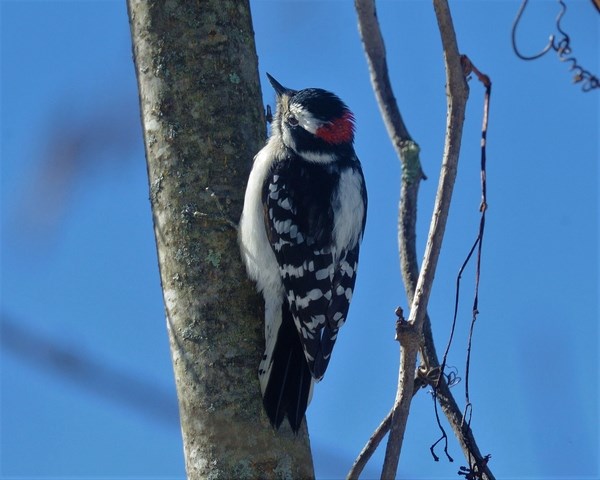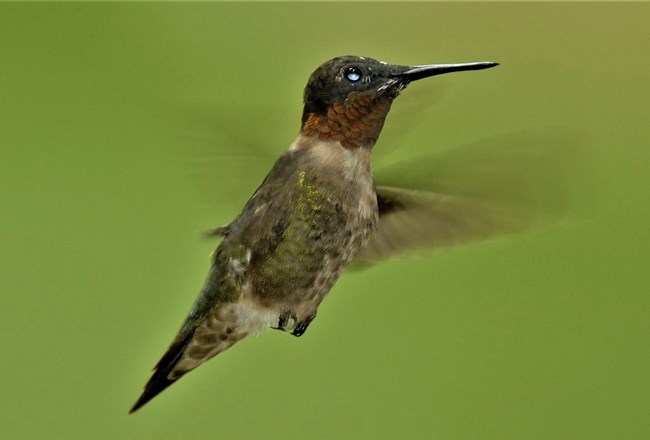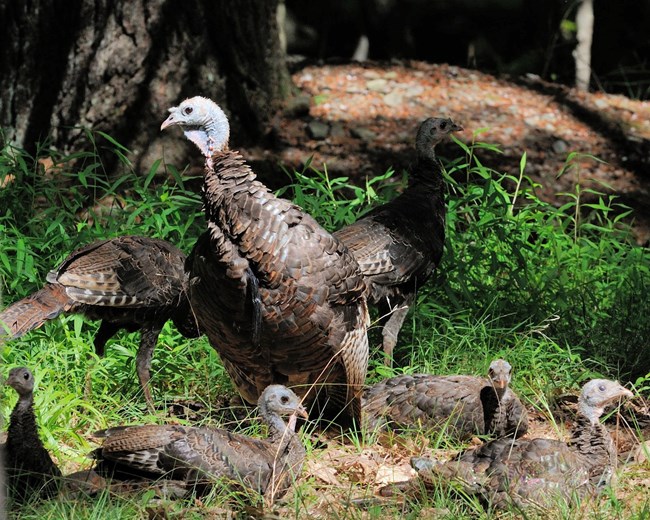
Scott Rando In addition to the larger groups of birds found in the Upper Delaware Region, such as waterfowl and perching birds, many other birds inhabit the river valley that don't fall into these categories. Examples include woodpeckers, hummingbirds, Wild Turkeys, and the Belted Kingfisher. Woodpeckers are noted for their unique foraging behavior. They probe at tree trunks with their beaks, searching for insects in the bark. Their diet consists mostly of insects, but some eat fruits and berries in addition. Some woodpeckers even consume sap from trees. For example, the Yellow-bellied Sapsucker drills wells into trees to reach the sap inside. They target tree species with higher sugar contents in the sap, such as Yellow Birch or Red Maple. Woodpeckers can also often be seen drumming on hollow trees, branches, logs, and even fence posts. When woodpeckers drum, they quickly peck their beak back and forth on an object to create a distinct sound pattern. Attracting a mate and communicating territory boundaries are the two main reasons why woodpeckers drum. In addition, woodpeckers might drum to tell mates about new food sources or get help at the nest. 
Scott Rando Hummingbirds are another group of birds found in the Upper Delaware Region. They are tiny birds with long narrow bills. Hummingbirds usually only weigh between 2 to 20 grams. Their nests and eggs are also small. For example, the Ruby-throated Hummingbird's nest is the size of a thimble, and the eggs are as small as peas. Hummingbirds' diet consists mostly of nectar, in addition to small insects and spiders. Due to their high-energy lifestyle, they are constantly searching for food and feeding. Every day they consume about half their weight in sugar. Hummingbirds are also impressive flyers; they are the only bird with the ability to stop and hover in midair. The Ruby-throated Hummingbird's wings may beat 70 times per second while in flight. These small and agile birds are also extremely aggressive; they're not afraid to harshly defend their territory from larger intruders like crows and hawks. 
Scott Rando Visitors may also encounter Wild Turkeys in the Upper Delaware Region. Wild Turkeys are large birds with long necks and small heads. Their plumage is an iridescence brown green. Often found foraging in the forest, their diet consists of acorns, seeds, berries, and insects. Male turkeys will gobble and fan their tails to attract females. They usually create a shallow nest on the ground with leaves and plant material. After hatching, the young depend entirely on the female who teaches them how to feed while the male doesn't provide any parental care. The Belted Kingfisher is another common bird found in the Upper Delaware Region. Belted Kingfishers have a long, pointed bill and shaggy crest on their head. Their plumage is mostly slate blue on top, and the underparts are white. Females can be distinguished from males by the rusty orange coloring on their underside. Belted Kingfishers are often seen along the river, where they feed and make their nests. Their diet consists mostly of fish in addition to some crustaceans, mollusks, insects, and amphibians. Adult Belted Kingfishers often regurgitate bones, fish scales, and arthropod shells. However, nestlings have acidic stomachs that can digest these items. Belted Kingfishers nest in burrows on soft riverbanks. The regurgitated pellets from adults accumulate in the burrow and provide insulation. Common birds in the Upper Delaware Region include: Belted Kingfisher (Megaceryle alcyon) Chimney Swift (Chaetura pelagica) Downy Woodpecker (Dryobates pubescens) Hairy Woodpecker (Dryobates villosus) Mourning Dove (Zenaida macroura) Northern Flicker (Colaptes auratus) Pileated Woodpecker (Dryocopus pileatus) Red-bellied Woodpecker (Melanerpes carolinus) Ruby-throated Hummingbird (Archilochus colubris) |
Last updated: March 10, 2021
